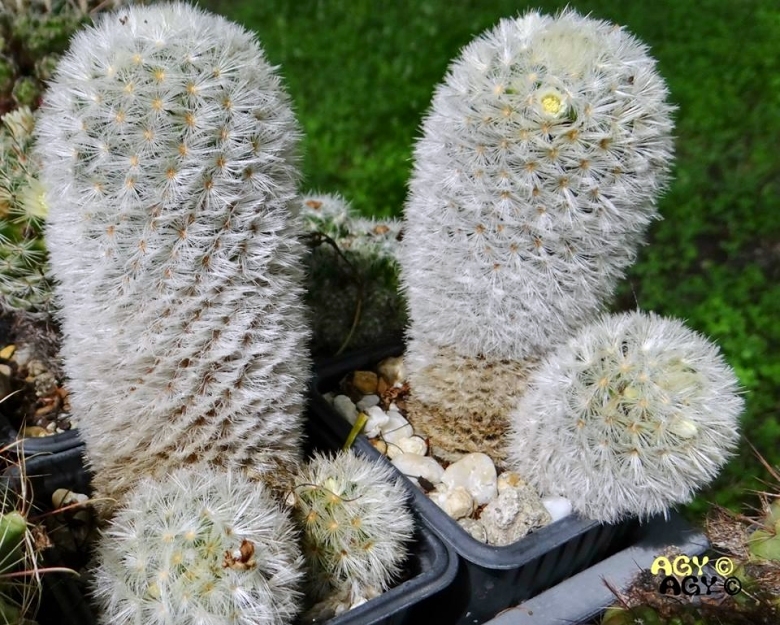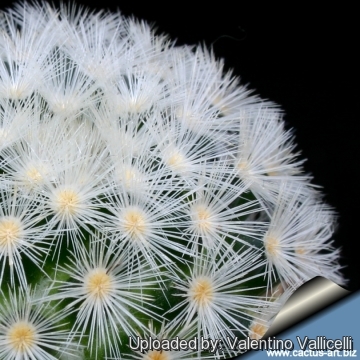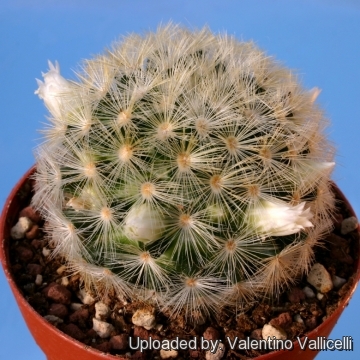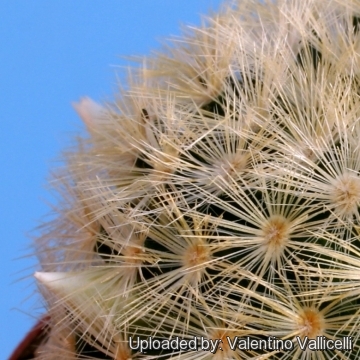Accepted Scientific Name: Mammillaria carmenae Castañeda
Anales Inst. Biol. Univ. Nac. Mexico 24(2): 233 (-235; fig. 12). 1954

Mammillaria carmenae f. albiflora Photo by: Agócs György
The 'albiflora' form develops a lovely white puffs with eventual offsets and splendid pure white blooms, in time expands so that its tubercles become well separated and its developing spines stand out beautifully against the mid green of the plant body.
Origin and Habitat: Garden origin (Nursery selected white flowering selection). The natural species is endemic to a very small area, Between Ciudad Victoria and Iaumave, Tamaulipas, Mexico, Northern America.
Synonyms:
See all synonyms of Mammillaria carmenae
back
Accepted name in llifle Database:Mammillaria carmenae CastañedaAnales Inst. Biol. Univ. Nac. Mexico 24(2): 233 (-235; fig. 12). 1954Synonymy: 5
back
Description: Mammillaria carmenaeSN|20921]]SN|20921]] is a solitary or clustering globular cactus.
Stems: Globose to ovoid, 4 - 10 cm high, 3 - 5 cm in diameter. Without latex.
Tubercles: Conical.
Axil: Woolly and bristly.
Radial spines: More than 100, soft, fine, flexible, star-like, pure white 5 mm long.
Central spines: There are no central spines.
Flowers: Daytime pure white, to 11 mm long.
Blooming season: Plants blooms at the same time in late winter-early spring and are very generous with their flowers.
Remarks: The point of interest of "forma albiflora" are the white spines and flowers..
Subspecies, varieties, forms and cultivars of plants belonging to the Mammillaria carmenae group
Bibliography: Major references and further lectures
1) Nathaniel Lord Britton, Joseph Nelson Rose “Cactaceae: Descriptions and Illustrations of Plants of the Cactus Family” Courier Dover Publications, 1963
2) James Cullen, Sabina G. Knees, H. Suzanne Cubey “The European Garden Flora Flowering Plants: A Manual for the Identification of Plants Cultivated in Europe, Both Out-of-Doors and Under Glass” Cambridge University Press, 11/Aug./2011
3) David Hunt, Nigel Taylor “The New Cactus Lexicon” DH Books, 2006
4) Edward F. Anderson “The Cactus Family” Timber Press, 2001
5) Clive Innes, Charles Glass “Cacti” Portland House, 01/May/1991
6) Fitz Maurice, B, Fitz Maurice, W.A., Hernández, H.M., Sotomayor, M. & Smith, M. 2013. "Mammillaria carmenae." The IUCN Red List of Threatened Species. Version 2014.3. <www.iucnredlist.org>. Downloaded on 21 December 2014.
 Mammillaria carmenae f. albiflora Photo by: Valentino Vallicelli
Mammillaria carmenae f. albiflora Photo by: Valentino Vallicelli Mammillaria carmenae f. albiflora Photo by: Valentino Vallicelli
Mammillaria carmenae f. albiflora Photo by: Valentino Vallicelli Mammillaria carmenae f. albiflora Photo by: Valentino Vallicelli
Mammillaria carmenae f. albiflora Photo by: Valentino Vallicelli Mammillaria carmenae f. albiflora Photo by: Valentino Vallicelli
Mammillaria carmenae f. albiflora Photo by: Valentino VallicelliCultivation and Propagation: It is a relatively rapid growing species. This is easily grown into clumps, but it does often have an irregular pattern of offsetting. Water regularly in summer, but do not overwater (Rot prone) Use pot with good drainage and a very porous potting media, keep dry in winter. Feed with a high potassium fertilizer in summer. It is quite frost resistant if kept dry, hardy as low as -5° C. Outside full sun or afternoon shade, inside needs bright light, and some direct sun.
Easily clustering and easily flowered. Most plants will offset readily, and clumps can be produced in a few years.
Propagation: Division, direct sow after last frost.















